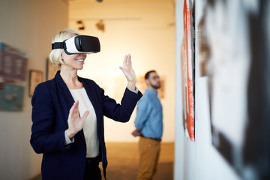
There have been many thought provoking discussions about the future of virtual reality (VR), especially as some of the top tech companies have unveiled their plans for how VR technology can be used to enhance several types of experiences.
While many are excited about the prospect of technology adding value to the arts, naturally there are questions pertaining to how it will be implemented. A lingering question among experts is how we can utilize VR to its fullest potential while maintaining elements that make regular museum trips so special for guests.
Frederica “Freddi” Wald realizes that the future of utilizing virtual reality technology to improve the museum going experience is bright, and institutions are already taking steps to implement VR as the technology continues to improve.
Here, she explores a few existing examples as well as what future implementations may look like for art enthusiasts.
How Are Institutions Currently Implementing VR?
One of the most appealing aspects of implementing VR at cultural institutions is that there are many ways to do so. To this point, museums have already found creative ways to include VR in an immersive and innovative fashion.
A shining example is the work that the Metropolitan Museum of Art has done to utilize VR projects over the years. For example, in 2017 the museum unveiled the Met 360° Project, which included six short videos that allowed viewers to experience attractions such as the Great Hall, the Temple of Dendur, and arms and armor galleries from their computers, smartphones, or VR headsets.
Last year, the Met also implemented virtual reality tours through The Met Unframed, a project launched in partnership with Verizon. This five week project allowed those interested in art to freely roam a virtual reconstruction of the museum. The VR experience also included audio-tour explanations, mini-games, and various historical details to add more context and fun to the experience.
There have been efforts to provide VR experiences at a host of other museums around the world as well. Institutions such as the Louvre and the British Museum, and many others have found innovative ways to include virtual tours, many of which are available for viewing through VR headsets.
How Does VR Add to the Museum Experience?

As Head of Membership at the Metropolitan Museum of Art, Freddi Wald is incredibly aware of the fact that museum goers want to feel as though their visits were worth it. Experts in cultural institutions recognize the importance of adding value as a means to improve guest experiences, gain members, attract donors, and show the utmost respect for artists and their pieces.
Virtual reality is often seen as a logical next step for museums because it can add value to museum experiences, which is becoming even more notable as efforts are made to improve the technology and its reach.
For example, one of the most cited ways that virtual reality can add to the museum experience is by increasing access to the arts. People who may not be able to visit a particular museum to enjoy its art can have an easier time doing so when VR options are made available. The experience is further enhanced for people experiencing VR at these institutions as well, because the technology can increase accessibility of artwork by adding much needed context to pieces.
Frederica Wald has noted in conversations linked to virtual reality that there are a variety of benefits for the artists as well. The artistic community is always looking for visually dynamic ways to showcase their work and connect with their audience. Not only can VR provide a platform for this, but it can also introduce a new medium for artists to explore. This is becoming more apparent as the technology improves with time.
The Future of VR in Cultural Institutions
As VR continues to develop, there are a lot of questions about how these improvements will impact its use in cultural institutions. One area that museums are looking to improve is the responsiveness of the technology. A more seamless experience will go a long way for pushing the needle forward in the future.
Frederica Wald recognizes that, for virtual reality to have a sustained impact on the arts over time, there will need to be a few upgrades that improve its ease of use. For example, cleanliness of headsets and associated VR technology is a concern.
There is also a lot of work required for rendering even semi-realistic settings in VR, and the space will need time to create virtual worlds as intuitive and visually striking as we imagine them. After all, there is a reason why most of the VR experiences available in museums are technically augmented reality (AR) rather than full virtual landscapes.
Freddi notes that these minor details will likely not stop cultural institutions from investing in the technology, as they have much to gain from its implementation. While we may be years away from fully virtual museum landscapes, many experts believe that cultural institutions will strike a balance that will make the digital experiences rival in-person ones.
For now, it is a safe bet that museums will continue to improve their VR technology to add important context to pieces and improve access to the arts. As the space adapts and grows, it is also becoming increasingly likely that artists will use VR technology for inventive, immersive artistic experiences- and many believe this will present a number of interesting opportunities for artists around the world.


